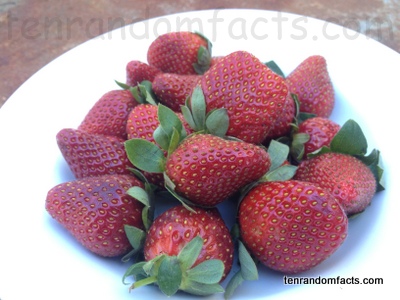Sweet, juicy, mouth-watering strawberries.
- Strawberries are also called ‘garden strawberries’ and are from the family Rosaceae, which is the family of roses, and are not proper berries.
- There are more than 20 species of Fragaria, or strawberries as they are known, with Fragaria × ananassa being the most commonly grown hybrid.
- Strawberries are typically sweet, heart shaped red, juicy fruits, and generally grow on a 15 cm (6 inches) high plant that spread out on the ground to about 50–100 cm (20 – 40 inches).
- Strawberries can be made into jam, juice, milkshakes or made into cakes or desserts, or eaten with or added to ice cream, yoghurt, chocolate, pancakes and so on.
- Strawberries have approximately 200 small yellow achenes, that look like seeds and are actually the ‘fruit’ of the strawberry, on the outside of the flesh, which contain a seed inside each.
- Cultivated strawberries are generally sweeter than the wild species, with the garden type becoming very popular due to its sweetness, and they should be eaten within two or three days from purchasing or picking, as they can easily become bruised, mouldy or decayed.
- Strawberries only ripen on the plant, and are green or white if not ripe, although some varieties of strawberries are white when ripe.
- In 2011, USA, was by far the world’s top producer of strawberries, producing over one quarter of the total world production of 4,200,000 tonnes (4,600,000 tons) with Spain ranking second.
- Some people are allergic to strawberries with reactions similar to hay fever, hives and possibly breathing problems and can cause anaphylaxis, although some of the white strawberry cultivars may not cause a reaction.
- Strawberries are a good source of antioxidants and are very high in vitamin C, with one serve providing close to your daily recommended intake.
Bibliography: Strawberry, 2011, Fresh for Kids, <http://www.freshforkids.com.au/fruit_pages/strawberry/strawberry.html>
Strawberry, 2013, Wikipedia, <http://en.wikipedia.org/wiki/Strawberry>






